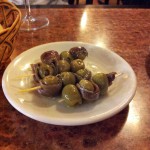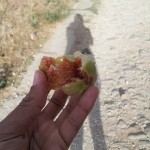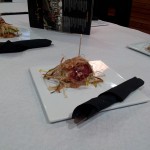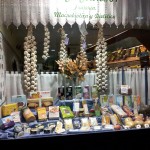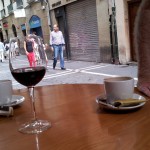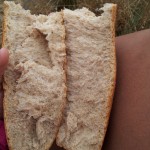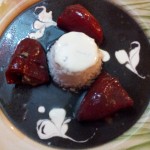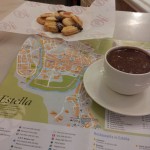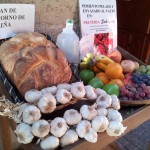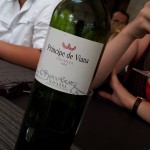Dear Seattle –
I’ve heard two things about the Camino:
- It’s the perfect place to go on a diet.
- It’s the worst place to be on a diet.
The good news is, walking 15-25km a day while carrying upwards of 10% of your body weight in backpack does wonders for your metabolism. 10 days in I’m not sure I’ve lost any weight, but I’m darn sure I haven’t gained any. I’m feeling a bit more trim though, and stronger than I was when I started this adventure. Which is something of a miracle all things considering I would agree with #2, but #1 also works if that diet includes lots of vino tinto (red wine), cheese, and white bread.
Besides our feet and the state of the next bed, food is one of those conversations that comes up a lot on the Camino. The Peregrino Menu is the standard that most restaurants offer for lunch/dinner. Three courses consisting of an appetizer (usually soup, salad or pasta), an entree (meat based), and desert (flan, anyone?). Lest I forget, a large basket of (freshly baked) bread, and a bottle of tinto vino joven (young red wine) – or two, depending on the size of the group and the generosity of the establishment. Breakfast is a cup of coffee, a toast and jam and orange juice. Breakfast will run about 3-5 euro, and dinner about 9-12 euro. It’s budget food, for travelers who are staying in hostels that usually cost under 15 Euro for the night.
It’s hard to imagine you can get much variety in a meal like that, and I’ll confess, I’m already bored with it. I’ve learned to avoid the past in most places, (overcooked) and the pork and the beef. Not being a fan of flan, I take the opportunity to have a fruit salad. For breakfast, a slice of a Spanish Tortilla (which is more like a potato omelette than it’s Latin American cousin) is a welcome change. Lunch on the road is often a baguette, some cheese and a few slices of ham, plus whatever fruit we’ve been able to scrounge up.
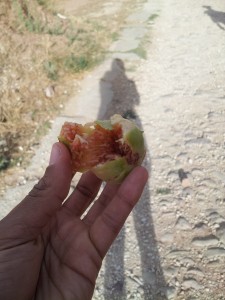
But what does change is the quality. Most pilgrim’s menus are served at one or two preset seating times (usually 7pm). It’s like happy hour dinner, or more accurately, the blue hair special – considering most of us are yawning and headed to bed by 10pm. However, some towns have really made an effort to make the pilgrim’s menu interesting by including a house specility in the choices or a really nice bottle of wine.
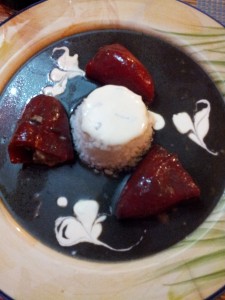
Two of my favorites so far have been the Spinach and Garbanzo bean soup in Navarrete, and the Sunday lunch extravaganza we had in Pamplona. To be fair, the Pamplona feast was really a menu of the day not connected with the pilgrimage, and at 17 Euro was not one of our cheaper feeds. But since lunch is generally cheaper than dinner, it was a bargain of a way to sample some amazing plates and fantastic wines usually out of range of the peregrino budget. (Mushroom and bacon crepes anyone?) Even the “young” vino tinto (red wine) was better than most bottles I’ve had in the states. Maybe it was the fact that we were sitting on the main square in old Pamplona that seasoned the flavor.
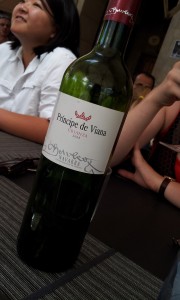
Fruit and vegetables are not common on the meal table, but can be had at local supermarkets. The other day we hit on a bag of spinach which was like manna from heaven. Lightly steamed and salted it was probably the most amazing thing I’ve ever tasted. My digestion was grateful.
Lunches on the road are often shared affairs if there’s no cafe to stop at. Sitting on a culvert near the trail one afternoon Paul, Kayla and I pieced together the most amazing sandwiches from a sliced tomato, whole wheat bread and cheese, finishing off with apple slices, dried raisins and the last of the spicy mango slices I’ve been hoarding since I left Seattle. It was divine.
Food has an important place in our lives now: We celebrate milestones with meals like Pamplona’s feast; our first week on the road; REAL hot chocolate at the 100km mark; and begin each dinner with a toast to sample our young red wine. Paul has even introduced me to the habit of inquiring about the locally made “digestif” after dinner – which is a great way to engage the local bartender and learn a little bit more about the town and the people. Not sure if it’s actually helping my digestion any.
In some ways, life on the road revolves around food, because – to be blunt – walking all f*cking day is a helluva way to work up an appetite. For the first week, I felt as though I couldn’t eat enough. Kayla and I joked about the compulsion to hoard sugar packets and clean out the plastic jam containers: “Are you gonna finish that butter pat?” would leave us breathless with laughter before we finished cleaning the last of the breadcrumbs from our plate. There are sometimes I still crave bread, but mostly these days it’s fruit and greens. I could eat a whole field of kale.
Food is another thing that brings us together on the Camino. My particular group of walking companions range in age from early 20’s to early 50’s. The five of us are from four different countries (the US, Kenya, Sweden and two Canadians). And this is just the “core group” that seems to find ourselves finishing up the day around the same time or walking together at some point during the day. No matter how different our backgrounds, food is one of those conversations that we can always engage in. There’s nothing better to pass the time on the long flat stretches in the middle of the day than a bit of reminiscing over a fabulous cheese plate or the rare loaf of whole grain bread that someone discovered. Making that last 5k of the day fly by is much easier when debating the best wine or the funniest mealtime language barrier issue.
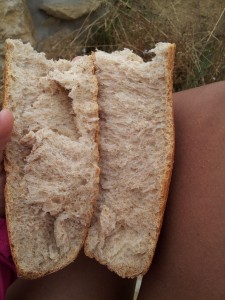
Other familiar faces often catch up around mealtimes. People I haven’t seen all day, or for a day or two turn up unexpectedly in the same restaurant. Sitting together and sharing a meal is a way we stay in touch with one another. This afternoon I finally got news of a guy named Bill from Texas. Kaya, Jed and I met Bill and had dinner together on the first day in St. Jean. He was a big guy and a little underprepared for the Camino, but was probably one of the nicest people I’ve ever met. We hadn’t seen or heard from him since and often wondered what happened to him and how his Camino was going. Tonight we heard he’s a few days behind us, and doing well. It was good news, and worth a toast.
So the Camino may not be the ideal place to diet, but it’s the perfect place to enjoy a good meal among friends.
